Happy Mushroom Monday FungiLovers! This last weekend was a particularly exciting weekend for me since I was blessed enough to stumble upon the largest fruitings of chanterelles I have yet witnessed. With a heavy rain in the middle of last week, and warm, humid weather on the weekend, conditions were absolutely perfect for chanterelles. I thought for sure that I would come across at least one or two given the conditions, but I never would have imagined that I would have come across as many as I did!
Along with a bounty of other bolete species, I came across three different species of chanterelle this last weekend: The Smooth Chanterelle (Canthatellus lateritius), the Golden Chanterelle (Cantharellus cibarius complex), and the Red Chanterelle (Cantharellus cinnabarinus). In addition to these different chanterelle species, I also came across one of chanterelle's most notorious, poisonous look-alike species: the Eastern American Jack-O'-Lantern mushroom. Given my luck of finding all of these species growing in such close proximity, I figured that this was a perfect opportunity to differentiate these species from one another so that others can be more confident in their own identification skills and avoid falling prey to trickery of the poisonous Jack-O'-Lantern Mushroom!
For those that may be unaware, Chanterelles are among the most highly prized edible mushrooms native to both Europe and North America. Their history of culinary use stretches back hundreds of years, though their popularity saw a notable and sustained surge during the 18th century as the mushroom began gaining a delicacy status in French cuisine as popular addition to the dishes of French nobility. Though not a universal characteristic, many members of the Cantharellus genus possess a fruity aroma not too dissimilar from that of an apricot. Today, chanterelles are enjoyed by individuals across the globe for their complex flavor profiles. Being a mycorrhizal species (creates mutual relationships with tree roots), chanterelles cannot be grown commercially as is done with other edible species like oysters, lion's mane, and shitake. Instead, chanterelles must be foraged by hand from the wild, adding to their scarcity and status as a delicacy. Many of the flavorful compounds in chanterelles are fat soluble, making them ideal for frying in butter. Chanterelles are also particularly well-suited for dehydrating and then rehydrating, making them relatively easy to store for later use. Many chefs include chanterelles on a short list of gourmet edible fungi along with other heavy hitters like morels and truffles.
The first chanterelle species I would like to discuss is the Smooth Chanterelle. This small, pale yellow mushroom can be distinguished by its short stature (rarely more than 10 centimeters tall and 4-6 centimeters wide), bright yellow color, strong scent of apricot, and the presence of ridges on the underside of the cap rather than true gills.
These ridge, also known as "false gills," are a crucial characteristic to know how to identify if one wants to forage for chanterelles; the presence of false gills is the genus' most pronounced identifying feature. Whereas many cap and stem mushrooms will have gills on the underside of their caps that taper to sharp, easily defined edges, the false gills of a chanterelle are far more rounded and shallow in comparison to that of true gills. These false gills will also commonly display forking as well as cross-venation in some select species, which is typically absent most most other gilled species. Becoming familiar with the appearance of and difference between false and true gills is an essential step in positively identifying chanterelles. I have included pictures of the false gills on each of the three chanterelle species presented in this post as well as a picture of the true gills present on the Eastern American Jack-O'-Lantern mushroom so that those who may be unfamiliar with these structures can see how they differ.
Smooth Chanterelle (Cantharellus lateritius):
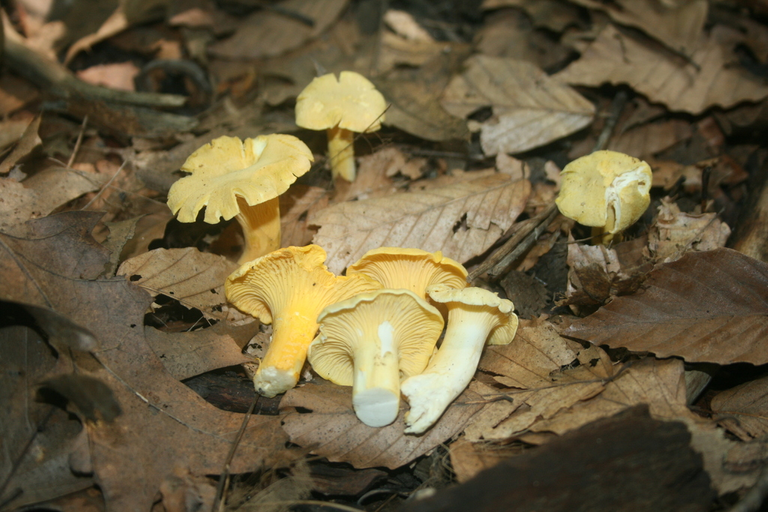
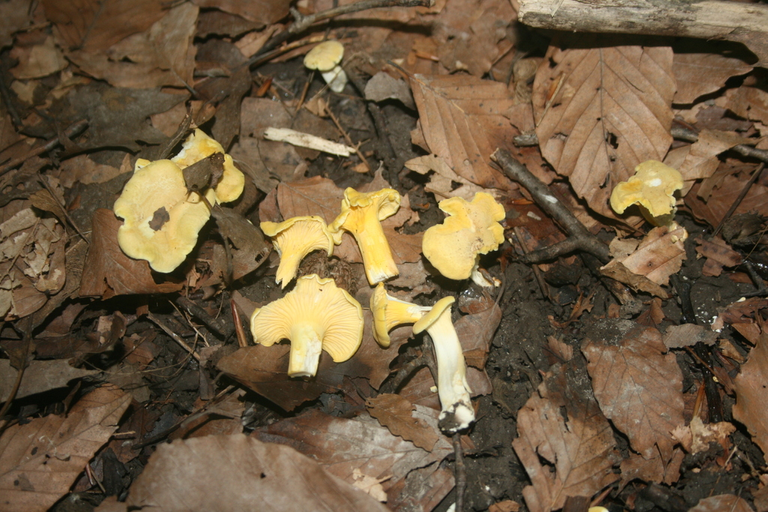
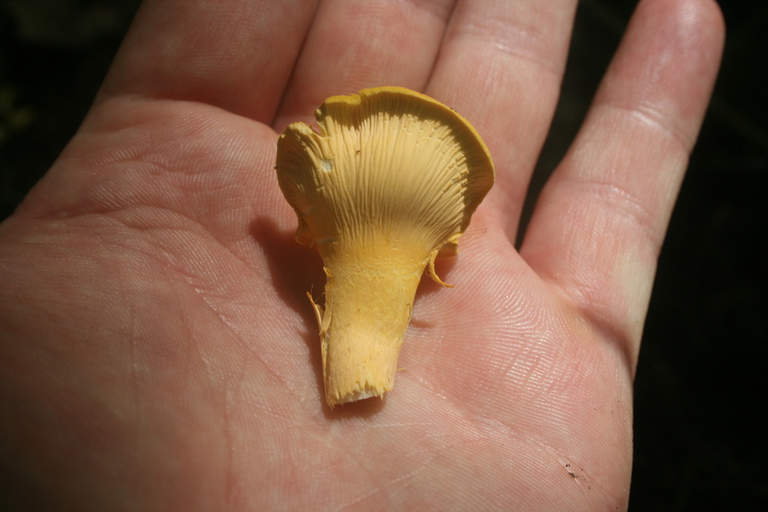
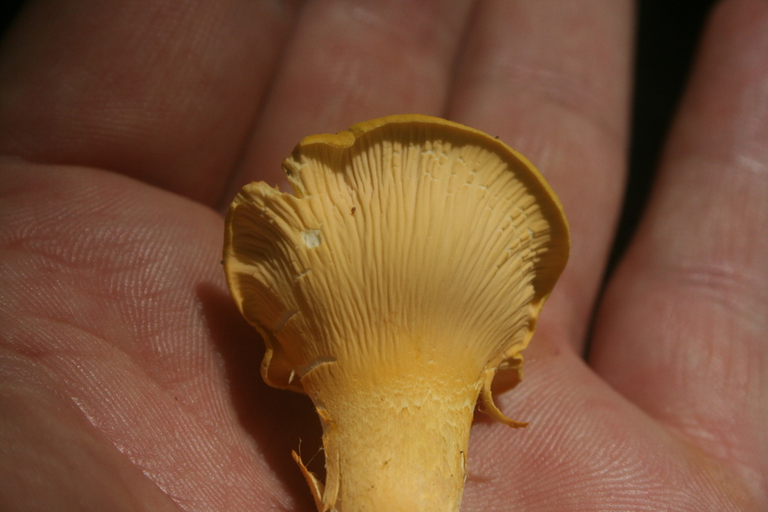
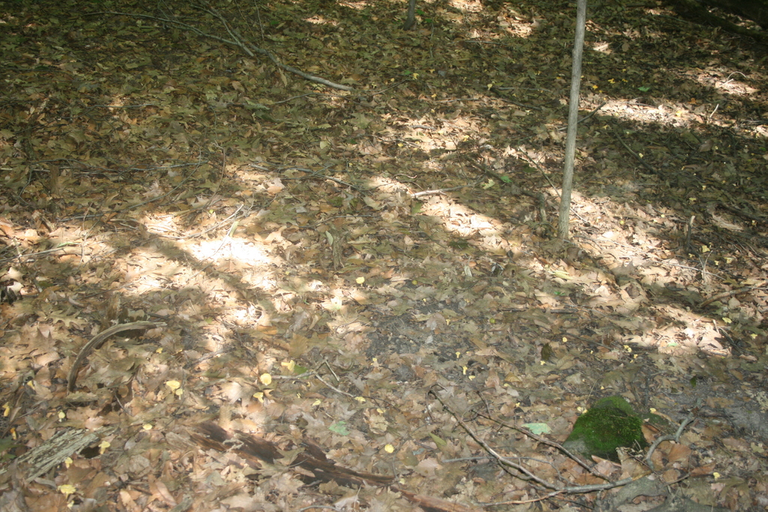
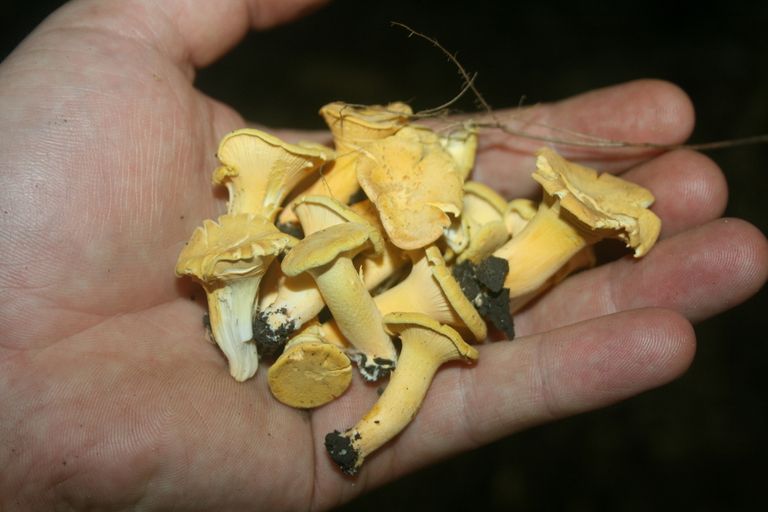
The second species that I came across is the Golden Chanterelle, or at least some kind of Golden Chanterelle. For decades, virtually all of the yellow/orange chanterelles in North America were classified as Cantharellus cibarius, however, DNA analysis has since revealed that these mushrooms are actually a group of North American chanterelle species distinct from their European cousins. The current number of North American species, as well as their common names, are still up for debate, so I have decided to identify this species as a member of the Cantharellus cibarius complex for the time being. In comparison to the Smooth Chanterelle, the Golden Chanterelle has a much meatier stature with a thicker stem and an often broader cap, though they still are rarely more than 10 centimeters tall. The scent of apricot is present with this species as well, though it is not as pronounced as with the smooth chanterelle, and the color is slightly more orange on the Golden Chanterelle. Like other chanterelles, Golden Chanterelles also exhibit false gills on the underside of their caps.
Golden Chanterelle (Cantharellus cibarius complex):
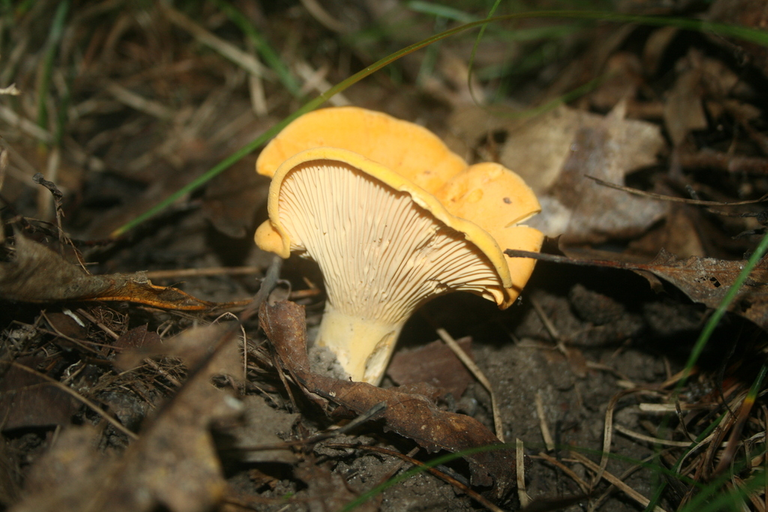
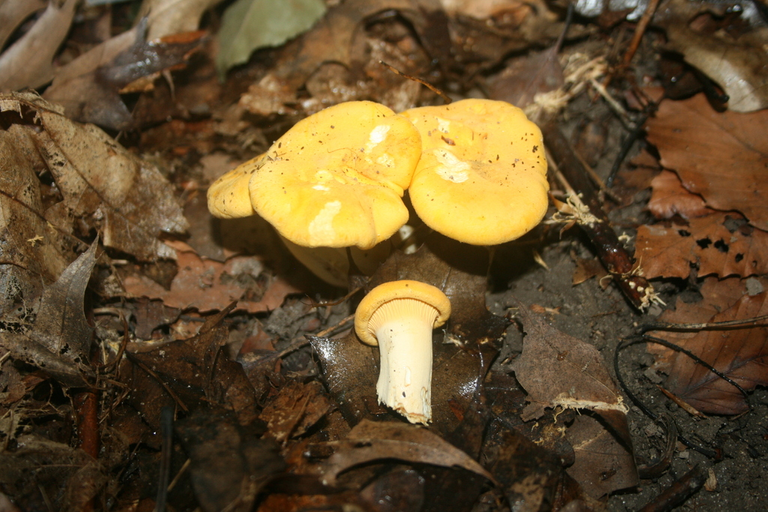

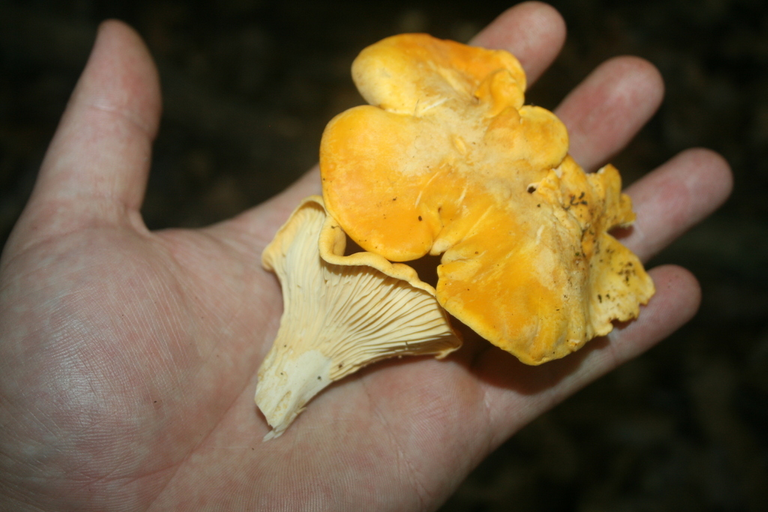
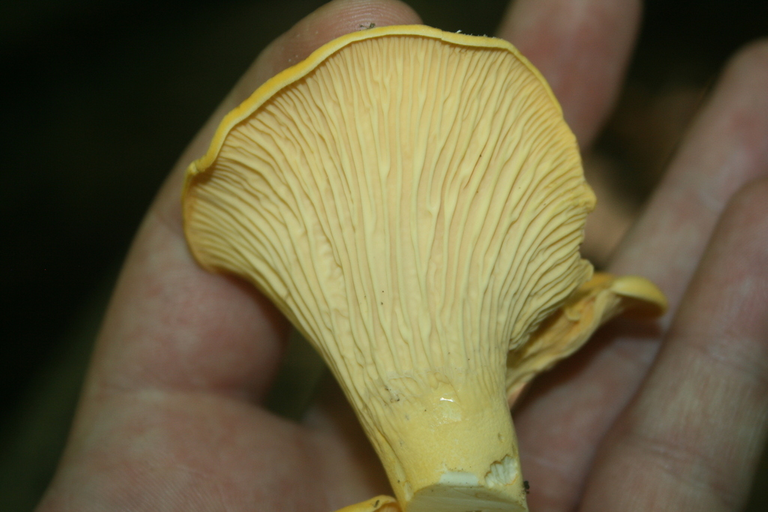
The Red Chanterelle is a third species native to eastern North America, and is often one of the easiest to spot sticking out from the litter of the forest floor due to its vibrant red-orange color. In my experience, this species tends to be smaller than the other two species already described, with a less broad cap. Despite their smaller size, they too are a delicious edible species.
Red Chanterelle (Cantharellus cinnabarinus):

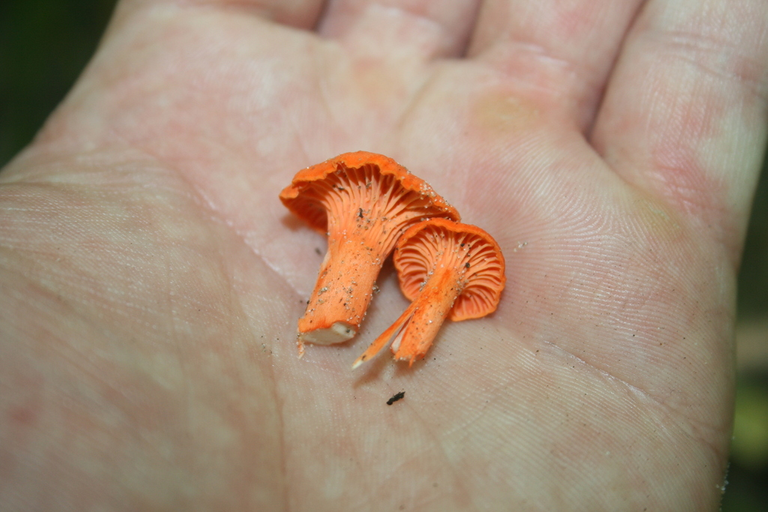
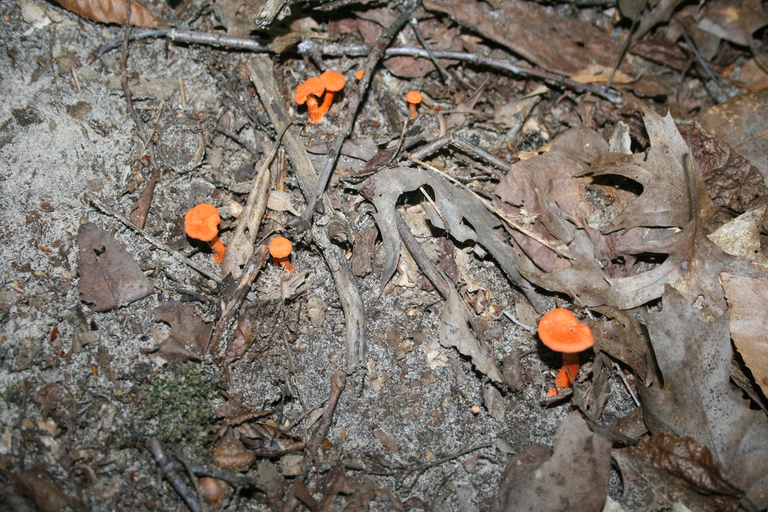
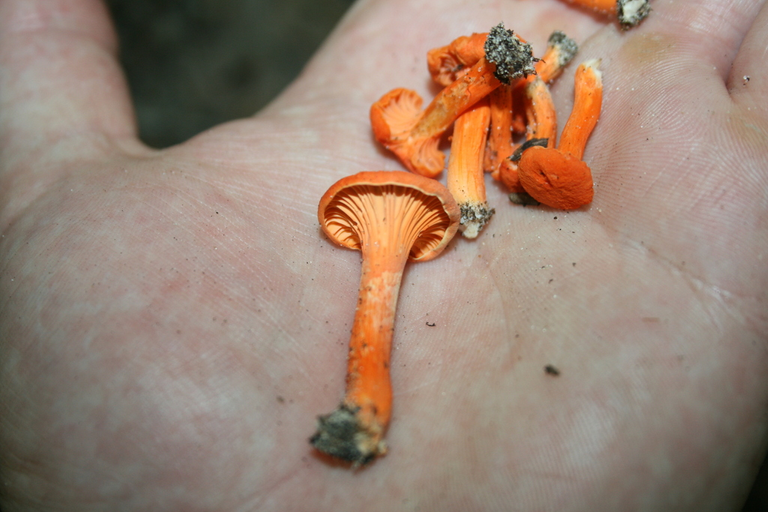
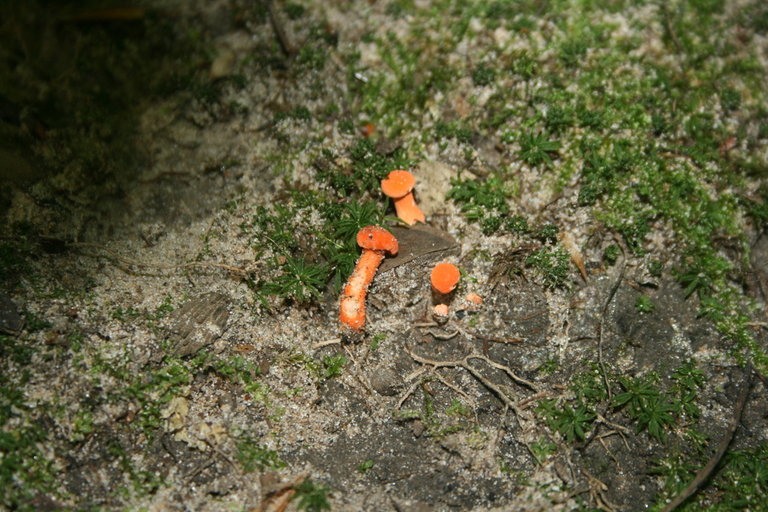
Now that we have familiarized ourselves with the general shape and coloration of a few chanterelle species native to eastern North America, it is time to introduce the Eastern American Jack-O'-Lantern mushroom. This is a poisonous species that will cause gastrointestinal distress, vomiting, and diarrhea if eaten raw or cooked due to the action of the toxins illudin S and illudin M, which prevent the transcription on DNA. Though toxic in their natural form, derivatives of illudins are now being used for experimental anti-cancer treatments, such as in the experimental drug Irofulven produced by MGI Pharma.
Most of those that accidentally poison themselves (or others) with this mushroom do so thinking that they were a large cluster of chanterelles, so it is important to be able to identify Jack-O'-Lantern mushrooms if one wishes to hunt for Chanterelles. Compared to a chanterelle, Jack-O'-Lantern mushrooms are much larger (reaching up to 30 cm or taller), grow in clusters that attach to a central base, and have true gills. Many sources will also report that this species glows in the dark for up to 40-50 hours after picking them, but I cannot corroborate these reports. After spending around 30 minutes in the dark of my apartment staring at this very fresh specimen of Jack-O'-Lantern mushrooms last weekend, I can confidently report that there was no bioluminescence whatsoever. Michael Kuo, a very well-regarded and knowledgeable mycologist who is the author of the website mushroomexpert.com reports that after years of attempting to observe this phenomena, he has never seen them glow either (Source:https://www.mushroomexpert.com/omphalotus_illudens.html). Unfortunately, this phenomena appears to be nothing more than misinformation.
Eastern American Jack-O'-Lantern (Omphalotus illudens):
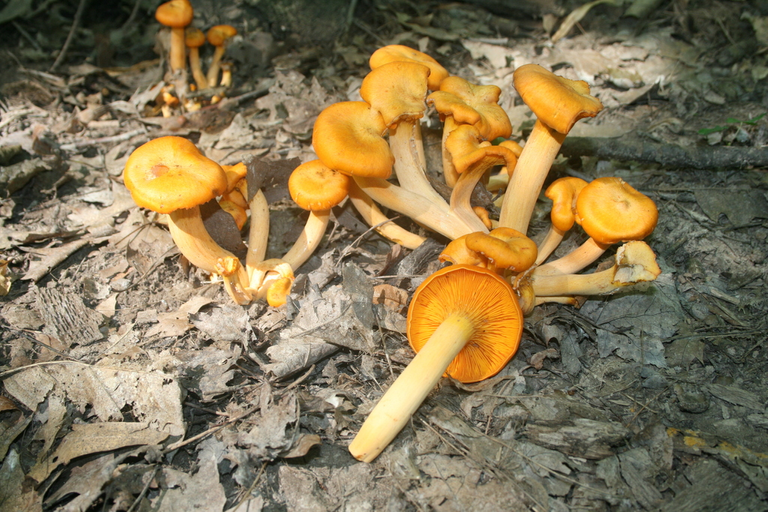
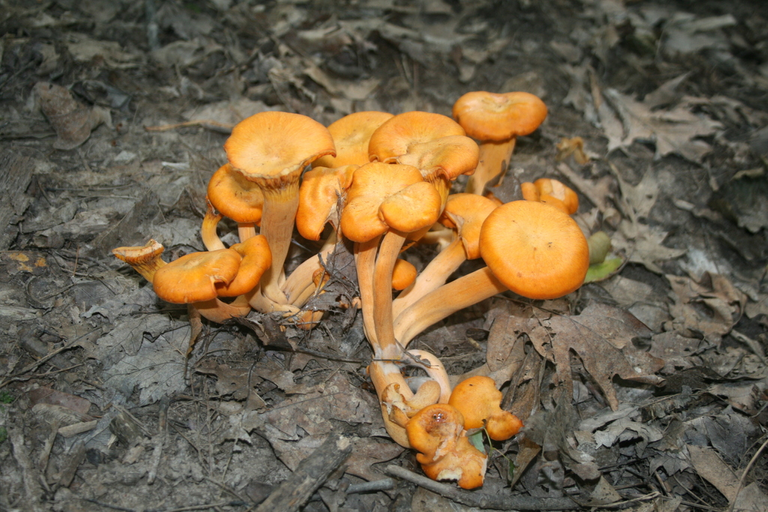
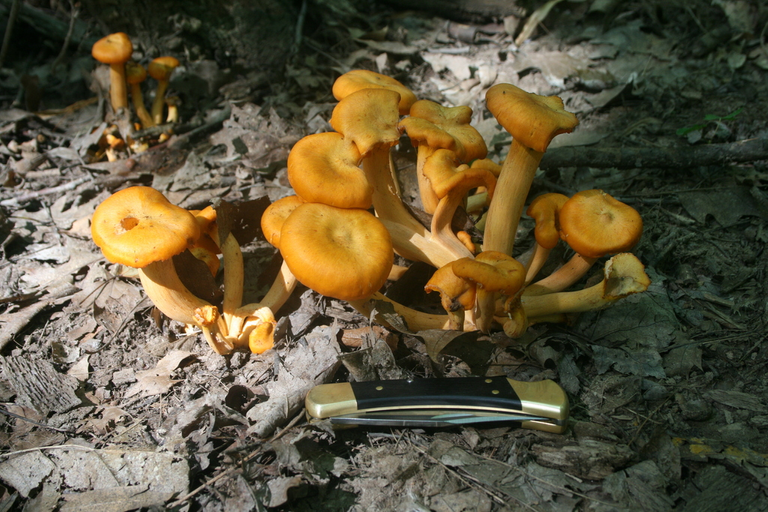
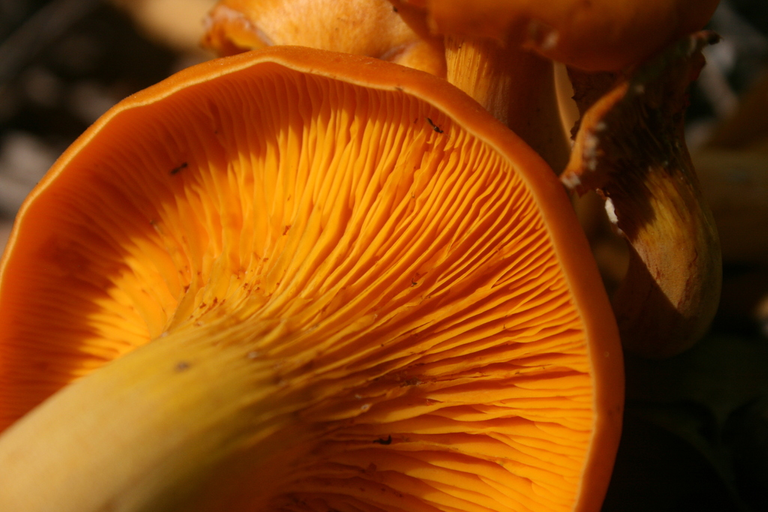
I hope that these images and descriptions help those who are interested in identifying chanterelles! This is by no means a complete list of chanterelles species or look-alikes that are native to eastern North America, but I hope that this may serve as an introduction for those that are interested in these highly prized culinary species. As always when collecting wild mushrooms, NEVER consume a species that you are not 100% sure is edible. If in doubt, throw it out. If possible, consult the expertise of a mushroom identification expert, and if unavailable, resort to these words of wisdom:
"There are old mushroom hunters, and there are bold mushroom hunters. There are no old, bold mushroom hunters."
Be safe, have fun, and happy Mushroom Monday!
My NFT Showroom gallery: https://nftshowroom.com/tych021/gallery
Creary Gallery: https://creary.net/@tych021/projects
Publish0x reflink: https://www.publish0x.com?a=M7e58kDYd2
PeakD reflink: https://peakd.com/register?ref=tych021
NFTShowroom reflink: https://nftshowroom.com/?r=tych021
Twitter: https://twitter.com/tych021
Vimm.tv: https://www.vimm.tv/tych021